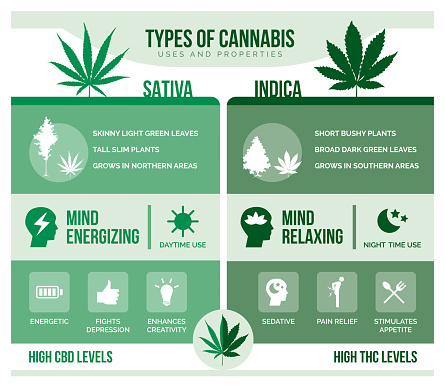It can be overwhelming to begin any new medical treatment, and medical cannabis is no different. You’ve probably wondered how to choose the right strain or even how to use your MMJ for the best possible results. Here we break down how to find the right medical marijuana strain for you and your condition.
Marijuana Plant Types
Before you get started on choosing the best strain, it’s important to understand the different categories of cannabis strains. Different strains of cannabis are like different types of ice cream flavors: They’re all part of the ice cream family, but they have varying tastes and sensations depending on how they were created.
There are two main subspecies of cannabis plants, sativaand indica. Both plant types, or even a combination of the two called a hybrid, can be used to achieve a variety of different effects.1
Sativa
Sativa strains come from the cannabis sativa plant type. They are known to produce an energizing effect that is commonly experienced as a “head high.” Strains in the sativa family typical have a higher amount of tetrahydrocannabinol, more commonly known as THC, which is the cannabinoid responsible for producing the “high” effects.2
Indica
Cannabis indica strains are known to create a full-body sense of relaxation. While they may contain a lower amount of THC than sativa strains, they typically have a higher level of cannabinol, the cannabinoid known to facilitate a calming effect.3 Medical cannabis patients and recreational users alike love using indica strains to help calm the body and mind.4
Hybrid
A hybrid strain is created when a professional marijuana grower combines the seeds of both sativa and indica plant to create a different strain. In most cases, a hybrid strain will produce a more balanced combination of sativa and indica effects.5Consumers or patients who are new to cannabis – or simply indecisive when it comes to choosing their strain – tend to lean towards hybrid strains to experience more balanced mind and body effects.
THC & CBD Content of Strains
It’s also important to note that, ultimately, the type of strain you pick will not determine your potential results. Types of strains serve more as general category titles that may or may not always be consistent.
In order to find your ideal strain, you must look at the cannabinoid content of each strain and pay attention to the ratio of THC to CBD.
THC (tetrahydrocannabinol) is one of the cannabinoids found in the cannabis plant. It’s what causes the ‘high’ effect people may feel when consuming cannabis products. Cannabidiol (CBD) is a non-intoxicating cannabinoid that works with the body’s naturally occuring Endocannabinoid System (ECS). The ECS helps regulate functions like sleep, temperature, mood, appetite, and immune function to help the body achieve homeostasis.
For patients seeking pain or inflammation relief, a strain with a higher level of CBD will be most likely to facilitate the healing process. A strain with a higher CBD content is also a great option for anyone who may be concerned about the potential of anxiety or other unpleasant feelings in a more THC-dominant strain. Finding a hybrid with a balanced blend of THC and CBD will generally produce enhanced effects of both compounds.3
Finding your perfect strain can be a series of trial and error, but it will be well worth it.
Types of Marijuana Strains for Medical Conditions
Now that you have a better understanding of the different categories of strains, you can decide what medical marijuana strain is best for you and can help you feel as good as possible.
What conditions can sativa strains treat?
Sativa is great for energizing and invigorating effects.3 No, that doesn’t mean you’ll be running around in circles all day. It simply means that you may feel inclined to be more productive and creative!
Some examples of popular sativa strains are Sour Diesel, Purple Haze, and Durban Poison.
Due to its energy-promoting effects, a sativa strain can be helpful in treating psychological or emotional conditions.4
Some medical conditions that can be treated with sativa strains include3,6:
- Anxiety
- Depression
- Chronic pain
- Sleep disorders
- Post-traumatic stress disorder
- ADHD, ADD
- Serotonin deficit
- Serotonin is a neurotransmitter in the body that affects mood regulation, sleep habits, anxiety levels and appetite.
If you choose to consume your medical cannabis through inhalation, it’s best to use a dry herb vape that allows you to customize your preferred temperature. For sativa strains, 310°F to 356°F is ideal for releasing cannabinoids that will promote productivity and creativity to help you through your day.7,8
What conditions can indica strains treat?
Indica strains are known for their relaxing effects.4 They also tend to have a higher amount of CBD, the cannabinoid that helps the body work towards relief and homeostasis.
Popular indica strains include more pungent, fruity strains like Bubba Kush, Northern Lights, and Grandaddy Purp.
Because of its soothing effects, indicas are often used to treat pain and inflammation, and may also reduce nausea.4
Some medical conditions that can be treated with indica strains include3,6:
- Arthritis
- Fibromyalgia
- Migraines
- Nausea
- Acute pain
- Low appetite
- Insomnia
- Lack of dopamine
- Dopamine is a neurotransmitter in the body that directly affects the brain’s reward and pleasure centers.
For patients who prefer to use a dry herb vape or inhale their medicine using another method, a higher temperature is recommended. If it’s more relaxation and calming effects you seek, 356°F to 392°F is ideal to make indica strains as effective as possible.8For patients dealing with insomnia or other sleep-related conditions, 392°F and up is best.7
What conditions can hybrid strains treat?
Since many medical conditions have associated side effects such as insomnia or depression, some patients prefer a hybrid cannabis strain.This allows them to reap the benefits of both indica and sativa strains with a more balanced level of effects that can treat both their condition and associated symptoms.5
Popular hybrid strains you might see on the shelf of your local medical dispensary include Blue Dream, OG Kush, and Headband.
The best way to decide on a hybrid strain is to speak with your medical provider or dispensary budtender. Since a hybrid strain contains elements of both sativa and indica strains, it will contain terpenes and flavonoids present in both plant types. A professional can explain if a certain hybrid strain is leaning more one way than the other, which is referred to as “sativa-dominant” or “indica-dominant.”2
How to Take Medical Marijuana
Before you begin your decision-making process, understand that the way you consume your medical cannabis mostly depends on your personal preference or any limitations you may have.
For example, if you are unable or prefer not to inhale cannabis products but want to treat chronic pain, a transdermal patch may be your best option. These medical patches are applied directly to the skin like an adhesive bandage and offer targeted relief to specific areas of the body.10
There are other smoking and vaping alternatives for those who prefer to treat their condition in a different manner.
Ingestible cannabis products such as gummies or capsules may be the way to go. These products, also referred to as edibles, are made with a marijuana oil or concentrate. They typically have a sweet and pleasant flavor that make them easy to consume. The effects of edibles can take anywhere from 15 minutes to two hours to kick in, while the effects of inhaling medical cannabis are typically felt within minutes.10
Pro tip: If possible, be sure to smell a variety of strains to see which one simply smells good to you! This will help you find the most suitable strain for your body. The natural plant terpenes released in a cannabis bud create a variety of scent profiles. Those that are pleasant to your senses are more likely to resonate with your body upon consumption.
No matter what condition you may treat with medical marijuana, there are plenty of options for you to take advantage of the positive effects of sativa, indica, and hybrid cannabis strains.
Sources
- Beginner’s guide to marijuana strains, Healthline
- Sativa vs. Indica: What to Expect Across Cannabis Types and Strains, Healthline
- Finding the Right Medical Marijuana Strain for You, Kind Meds
- Indica vs. Sativa, Cresco Labs
- What is hybrid cannabis? And is it right for me?, Greenstate
- Understanding the Differences Between the Two Cannabis Plants, Peace Naturals
- Best Temperature to Vape Weed: the Advanced Guide, Herbonaut
- How to Customize Your Cannabis High With Temperature, Leafly
- The Endocannabinoid System, Project CBD
- Ways of Consuming Medical Marijuana, United Patients Group






Leave a Reply